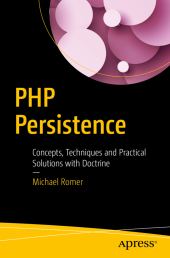 Neuerscheinungen 2016Stand: 2020-02-01 |
Schnellsuche
ISBN/Stichwort/Autor
|
Herderstraße 10
10625 Berlin
Tel.: 030 315 714 16
Fax 030 315 714 14
info@buchspektrum.de |

Michael Romer
PHP Persistence
Concepts, Techniques and Practical Solutions with Doctrine
1st ed. 2016. xi, 111 S. 9 SW-Abb. 235 mm
Verlag/Jahr: SPRINGER, BERLIN; APRESS 2016
ISBN: 1-484-22558-9 (1484225589)
Neue ISBN: 978-1-484-22558-5 (9781484225585)
Preis und Lieferzeit: Bitte klicken
Take the pain out of dealing with relational databases in an object-oriented programming world. With this short book, you can save time and money by simply coding less while accomplishing more with the Doctrine persistence framework, a leading persistence solution for PHP programmers and web developers. PHP Persistence teaches you about PHP persistence and how to use it effectively for your database-driven applications.
Bestselling author Michael Romer leverages his own vast experience to show you what you need to know about Doctrine 2 and how to use it in your own projects. Along the way you´ll learn about powerful persistence techniques, such as object-relational mapping (ORM) in PHP.
What You´ll Learn
Define entities and references between entities
Manage entities
Master the Doctrine Query Language
Use appropriate command-line tools for PHP persistence
Program for caching
Who This Book Is For
Experienced PHP programmers and web developers with some exposure to PHP.
1 About this book 1.1 Software version 1.2 Database system 1.3 Code downloads 1.4 Conventions used in this book 1.5 An important notice for Amazon customers 2 Introduction 2.1 Object oriented programming (OOP) & the Domain Model 2.2 Demo application 3 A self-made ORM 3.1 Loading an Entity 3.2 Saving an entity 3.3 Associations 3.4 Next steps 4 Hello, Doctrine 2! 4.1 Installation 4.2 A first Entity 4.3 A first Association 4.4 Core concepts at a glance 5 Defining entities 5.1 Mapping formats 5.2 Mapping objects to tables 5.3 Mapping scalar member variables to fields 5.4 Inheritance 6 References between Entities 6.1 One to one relationship, unidirectional 6.2 One to one relationship, bidirectional 6.3 One to many relationship, bidirectional 6.4 Many to many relationship, unidirectional 6.5 Many to many relationship, bidirectional 6.6 One to many relationship, unidirectional 6.7 Many to one relationship, unidirectional 6.8 One to one relationship, self-referencing 6.9 One to many relationship, self-referencing 6.10 Many to many relationship, self-referencing 7 Managing Entities 7.1 Creating a new Entity 7.2 Loading an existing Entity 7.3 Changing an existing Entity 7.4 Removing an Entity 7.5 Sorting an association 7.6 Removing an association 7.7 Life Cycle events 7.8 Cascading operations 7.9 Transactions 8 Doctrine Query Language 8.1 Introduction 8.2 Retrieving results 8.3 Constructing basic queries 8.4 Constructing join queries 9 Command line tools 9.1 Setting up the command line tools 9.2 DBAL commands 9.3 ORM commands 10 Caching 10.1 Introduction to ORM cache types 10.2 Caching backends 11 Advanced Topics 11.1 Zend Framework 2 integration 11.2 Native SQL statements 11.3 Doctrine 2 Extensions
Michael Romer manages agile software development projects and teams using Scrum and Kanban. He helps web startups with their products and technology and codes web applications, mostly with PHP, Zend Framework and Doctrine. He formerly worked for eBay.


